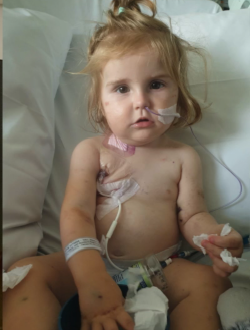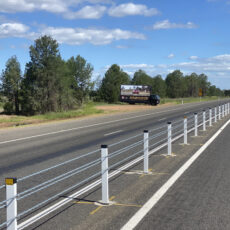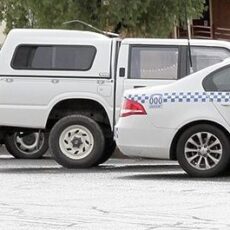Narrabri locals will be familiar with ‘Sean’s Two for Ten’ walkathon staged by the Narrabri Inner Wheel Club.
The event, based at the Selina Street walking track, is poised for a return this year on Sunday, April 7.
Part of a nationwide campaign, Inner Wheel clubs throughout Australia have been following and supporting the progress of research revolving around the donation of cord blood.
Proceeds from ‘Sean’s Two for Ten’ walkathon events held Australia-wide have contributed hugely to help researchers develop cures for various cancers and immunological diseases using cord blood stem cells.
Cord blood is the blood that remains in the umbilical cord and placenta after a baby is born, accessed once the umbilical cord has been clamped and cut.
Cord blood and cord tissue are both rich in powerful stem cells and can only be collected immediately after birth to be viable for potential future use.
Four-year-old Inverell resident, Elizabeth Hall, was injected with 30mls of the life changing stem cells in 2021.
Elizabeth was diagnosed at just 14 months old with a type of cancer of the blood and bone marrow that affects white blood cells, acute lymphoblastic leukaemia.

Proceeds from ‘Sean’s Two for Ten’ walkathon events held Australia-wide have contributed hugely to help researchers develop cures for various cancers and immunological diseases using cord blood stem cells. Pictured, Elizabeth Hall, Inverell.
The condition occurs when a bone marrow cell develops errors in its DNA. To date Elizabeth is doing extremely well and has become a regular at Inner Wheel A55 District Meetings.
The idea of an Inner Wheel national project was first floated in early 2000 by the current Inner Wheel Australia president Anne McGill.
Mrs McGill met with Professor Marcus Vowels, who oversaw the Cord Blood Bank at the Sydney Children’s Hospital at the time and is an authority on paediatric stem cell transplantation.
As suggested by Prof Vowels, a $65,000 grant was agreed upon for just one year.
In October 2000 guest speaker Dr Colin Storey from the Haematology Department of the Children’s Hospital Adelaide spoke in support of the Cord Blood Bank at the Inner Wheel Australia Annual Conference.
His enlightening presentation on the little-known subject completely won over members, and Mrs McGill welcomed immediate, overwhelming support for the project.
The idea was then adopted as a national project for a three-year period, with fundraising scheduled to begin officially on July 1, 2001.
The enthusiasm of Inner Wheel members for the project was such that it preceded this start date with more than $30,000 already collected by June 30, 2001.
It was later announced as an ongoing annual event with grants being presented at the Inner Wheel Australia annual conference to this day.
A medical panel was selected for consideration of recipients of grants with the help of Prof Vowels.
Application forms were sent out to all known contacts of researchers working in the field of cord blood research.
In addition, a volunteer transporting service was initiated by Inner Wheel from the Royal Prince Albert Hospital in Camperdown to the Cord Blood Bank in Sydney Children’s Hospital in Randwick.
This service, provided by local Inner Wheel Clubs and later joined by local Rotary Clubs, saves the Cord Blood Bank many thousands of dollars.
The hard work and enthusiasm for the new project meant there was enough money to present not one, but four grants totalling nearly $165,000 at the inaugural presentation in October 2002.
New initiatives began to surface with National Coin for a Cord Day and handmade toy bears created by Inner Wheel members for sale.
In October 2007, James English was the first guest speaker at an Inner Wheel Australia conference to have received a cord blood transplant.
That year nearly $1,000,000 was raised.
In 2011, for the first time since its inception, the appointed medical panel decided that none of the applicants were worthy of gaining a grant.
Whilst this revelation was disappointing for Inner Wheel Australia clubs, it cemented a new trust in the panel’s judgement – those hard-earned funds would strictly only be awarded to worthy recipients.
In 2015 came the launch of the ‘Gift of Friendship Rose’.
An international competition by Inner Wheel members to name a new rose was won by Inner Wheel Australia’s very own Mrs Anne McGill, an exciting announcement for the founder of the Cord Blood Research grant scheme.
Working in partnership with Treloar Roses, the $1 per sale awarded to Inner Wheel Australia soon amounted to more than $2000 in the first year of sales.
Featured in national garden magazines and on display at the Royal Melbourne Garden Show, the rose created a lot of welcome publicity for the Inner Wheel Australia organisation and the Cord Blood Research project.
That same year, the project was entered in the ‘Australian Events Award’.
It was a proud moment when ‘Cord Blood Day Inner Wheel Australia’ was awarded ‘State and Territory winner – Best Charity or Case Related Event’. Winning this award catapulted the project into the national realms of business and community awareness.
Each year, Inner Wheel Australia contribute to this ground-breaking science.
Every dollar raised goes towards research with a strict policy in place that no administration fees are applied to donations.
Since 2001, more than 55 philanthropic research grants have been awarded to cord blood scientific research organisations at the annual Inner Wheel Australia National Conference.
These grants amount to a combined amount of more than $3,000,000 contributed from regional Inner Wheel clubs across the country.
Initially there were pressing questions for doctors.
Was it possible to establish cord blood banks for unrelated as well as related transplants?
What would be the criteria for collection, quality control and preservation? In the early days, these factors dominated research.
In the last two decades research has substantially progressed, and investigations are branching out further into new fields of regenerative medicine.
Discovering remedial advantages of cord blood as a potential source of reparative stem cells, medical conditions currently under investigation include type 1 diabetes, cerebral palsy, Alzheimer’s disease, autism, burns, metabolic disorders, solid tumours, spinal cord injury, hearing loss and stroke.
The Inner Wheel Australia national project ‘Sean’s Two for Ten’ walkathon centres around Australian Sean Hill, now a 13-year-old boy.
Sean was born on January 1, 2011, with a rare genetic disease that severely compromised his immune system. Suffering more coughs and colds than the average child, a nappy rash that wouldn’t go away, unaccountable weight loss and months of numerous dismissive doctors’ visits, the family finally found the truth.
“On January 5, 2012, four days after Sean turned one, our lives were turned upside down,” recalled Sean’s mother Gloria Hill.
“As fate would have it, we had bumped into our early childhood nurse and guardian angel, Margot Malcolm, a week earlier, and she had noticed instantly that Sean was not well. She offered to pay us a visit at home and within five minutes of her arriving at our house, she urged me to make an appointment for Sean to see a doctor that very same day.
“Fortunately, we were able to see a new paediatrician, Dr Hugh Allen almost straight away. But unfortunately, the news was not good.”
Sean was diagnosed with a special type of pneumonia found in patients with a compromised immune system. Further tests over the next few weeks led to a definitive diagnosis.
After a week of intensive chemotherapy before the cord blood was flown to the Sydney Children’s Hospital, Sean underwent a life-saving transplant of stem cells derived from 30ml of cord blood.
The donation was flown from a baby 15,000km away using the world cord blood register.
The donation saved Sean’s life. The date was March 27, 2012, and Sean is now a healthy and thriving young teenager.
In October 2016 the Hill Family attended the Inner Wheel Australia Conference in Sydney, where Mrs Hill relayed their story. Sean is heralded as a success story among many others, and is the face of the Inner Wheel Australia cord blood campaign.
To order photos from this page click here




